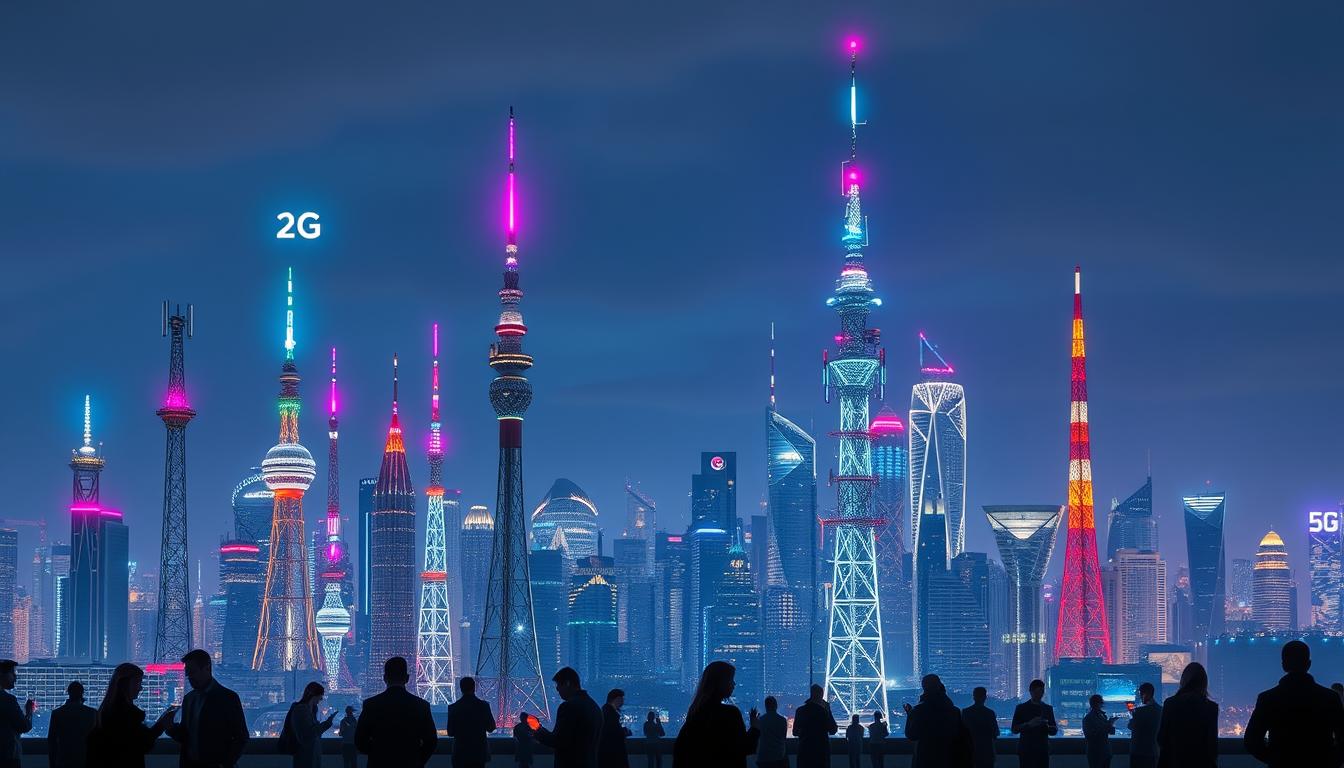The Evolution of mobile technology from 2G to 5G and beyond. While 5G is faster than 2G, mobile technology has seen a substantial change. This change has transformed the way we communicate with one another and the external environment. We now have smarter gadgets and better exchange of information methods because of it.
We’ll look at the significant advancements in mobile technology, from the early days of cellular networks to the current 5G. We’ll see how tech, infrastructure, and how we use devices have improved. And we’ll talk about what’s next in mobile tech.
Important Lessons
- Moving from 2G to 5G and more, mobile technology has made considerable progress, altering the way we interact with the outer world.
- Each new mobile network has brought big improvements in wireless communication. This has made devices smarter and connection better.
- The journey of mobile technology has seen many important milestones. These have pushed what’s possible in wireless communication.
- The principal advancements and potential of mobile technology will be investigated in this in-depth examination. We will discuss everything from the early days of cellular networks up to and including the present 5G.
- emerging domains such as the Internet of Things (IoT) and smart Cities have been created. Made feasible by the advancement of mobile technology.
Comprehending Generations of Mobile Networks: An Historical Approach
The story of mobile technology is one of amazing progress. It concerns the evolution of wireless communication and cellular networks. We need to look back at the start to actually understand How far we’ve come.
The Development of Cellular Networks
Engineers began developing a new mobile communication system in the 1970s. They split areas into smaller “cells” to use radio frequencies better. This led to the first mobile phone systems.
Key Milestones in Mobile Communication
- A new age began in Japan mobile communication in 1979 when it presented the initial commercial cellular network.
- The initial mobile networks, known as 1G, were presented in the 1980s and primarily managed phone calls.
- By enabling text messaging and bringing mobile data access, the introduction of 2G digital networks in the 1990s drastically changed communication.
- Since the debut of 3G networks in the early 2000s, mobile internet has grown speedy and the smartphone age is here.
- Common in the 2010s, 4G networks offer super-fast connectivity and help mobile apps to spread.
Problems with Early Adoption
Reaching our current position wasn’t easy. Early on, there were problems like limited coverage, high costs, and compatibility issues. But as things got better, mobile tech became more accessible and easy to use.
The story of mobile technology is fascinating. It’s about the creativity of engineers, the dreams of leaders, and our growing need for cellular networks, wireless communication, and mobile connectivity. Knowing this history helps us appreciate how much mobile tech has changed our lives.
The Boost of 2G: Digital Voice and Text Revolution
Mobile communication in a new era was ushered in by the transition of cellular networks from analog to digital. Introducing second-generation wireless communication, or 2G technology, changed how we utilize our phones. This change cleared the path for future developments in wireless communication and cellular networks and produced the extensive use of mobile connections.
Messages via text, also known as the Short Message Service (SMS), were created during the 2G era. This feature allowed users to send short messages, starting a new way of personal and business communication. The better voice quality and more network capacity of 2G made phones more useful and attractive to more people.
Mobile phone use grew fast during the 2G era as the technology became cheaper and more available. This increased demand for mobile connectivity helped pave the way for more advanced mobile data services. It set the stage for the next generation of cellular networks.
| 2G Network Capabilities | Key Advancements |
|---|---|
| Digital voice and SMS | Improved voice quality and network capacity |
| Enhanced security and encryption | Paved the way for mobile data services |
| Increased network reliability | Widespread adoption of mobile phones |
The 2G era was a key moment in mobile connectivity history. It laid the groundwork for the amazing advancements that followed.
3G Technology: Bringing the Internet to Mobile Devices
The introduction of 3G technology was a big step forward in mobile connectivity. It moved beyond the limits of 2G networks. 3G brought a new era of mobile broadband, changing how we use the internet and our devices on the go.
Mobile Broadband Emergence
With 3G, mobile users could enjoy fast data speeds. This allowed for smooth web browsing, video streaming, and instant communication. It made mobile connectivity more popular, as users could access lots of online content and services from their phones.
Smartphone Revolution Impact
The rise of smartphones was closely tied to 3G technology. These devices used 3G networks to change how we watch media, work together, and stay in touch. The network generations of mobile tech were key in starting the smartphone era, shaping our lives and habits.
Enhanced Data Services
- 3G networks supported many data-heavy services like high-quality video calls, mobile games, and apps that use your location.
- With faster data speeds and less delay, new mobile apps and services were created. This made the user experience better and helped the mobile connectivity world grow.
- The mix of 3G tech, smartphones, and better data services made it easy to access information and blend digital experiences into our daily lives.
The 3G revolution was a key moment in wireless communication. It opened up new possibilities and set the stage for the ongoing development of mobile technology.
4G LTE: The High-Speed Data Era
The new mobile connectivity era was escorted in with the introduction of 4G LTE. It changed how we access and use data on the move. This technology offered fast data speeds, making video streaming, voice calls, and new apps possible.
With speeds up to ten times faster than 3G, 4G LTE represented a significant advancement. This meant more people could enjoy rich content, share files instantly, and have smooth video calls.
The 4G LTE network also brought better features like lower latency and better spectrum use. These improvements made mobile network generations more efficient. They ensured a reliable mobile connectivity experience for many wireless communication uses.
| Key characteristics of 4G LTE | Effect on the User Experience |
|---|---|
| accelerated data rates (up to 1 Gbps) | Enabled seamless video streaming, high-made it possible for smooth video streaming, crystal-clear audio calls, and sophisticated mobile apps. |
| Latency reduction (less than 10 ms) | Increased responsiveness for interactive services and real-time apps |
| Increased efficiency of the spectrum | expanded network coverage and capacity to accommodate an increasing number of linked devices |
One significant development in mobile communication was the switch from 3G to 4G LTE. It opened the door to new mobile experiences. Additionally, it increased the popularity of cellphones and data-intensive apps.
“By allowing a smooth and engaging mobile experience that was previously unthinkable, 4G LTE technology has completely changed how we engage with the digital world.”
The Evolution of Mobile Technology From 2G to 5G and Beyond
Mobile technology has had an incredible journey. Each new generation brings big changes. The transition from 2G to 5G has altered how we interact and perceive the digital world.
Timeline of Technical Advancements
Mobile technology has grown a lot over the years. It started with simple digital voice and text in 2G. Then, 4G LTE brought fast data. With even faster speeds and improved connectivity, 5G is now available.
Infrastructure Development
The tech growth relies on better network infrastructure. As new mobile tech comes, the networks get better too. This includes new cell towers and advanced technologies like cloud computing.
User Experience Transformation
The changes in mobile tech have greatly improved our experience. From simple calls in 2G to fast streaming in 5G, it’s all changed. The future will bring even more, like augmented reality and the Internet of Things.
| Network Generation | Key Advancements | User Experience Improvements |
|---|---|---|
| 2G | Digital voice and text capabilities | Improved call quality and SMS messaging |
| 3G | Mobile broadband and smartphone revolution | Faster internet access and access to apps and mobile web |
| 4G LTE | High-speed data era | Seamless streaming, faster downloads, and enhanced multimedia experiences |
| 5G | Ultra-fast speeds, low latency, and massive connectivity | Immersive AR/VR, real-time IoT applications, and transformative user experiences |
“The development of mobile technology has completely changed how we communicate, work, and live. The limits of what is feasible have been stretched by each generation, and there are even more fascinating opportunities ahead.”
5G Technology: Unleashing New Possibilities
5G technology is ushering in a new era of wireless communication. In addition to joining numerous network generations and wireless communication devices, this next-generation 5G technology offers speeds and low latency. It has the potential to alter many aspects of our system and open up a world of possibilities.
5G gives fast data speeds of up to 10 gigabits per second. This speed allows augmented reality, remote healthcare, and self-driving cars. Additionally, answers are nearly instantaneous, which makes it ideal for pressing work.
Additionally, 5G can support a large number of devices simultaneously. This is transforming smart city initiatives and the Internet of Things (IoT). It opens up new possibilities for smart cities, improved resource usage, and safer public areas by enabling sensors, cameras, and other devices to communicate with the cloud and one another.
| Key 5G Advancements | Potential Applications |
|---|---|
| Blazing-fast data speeds | Augmented reality, remote healthcare, autonomous vehicles |
| Ultra-low latency | Real-time industrial automation, tactile internet, cloud gaming |
| Massive device connectivity | Smart cities, IoT, connected homes and businesses |
5G ushers in a new era of wireless contact. This technology will have an effect on how we live, work, and connect. The digital and physical worlds will coexist in this century, and there will be many prospects for development and creativity.

Network Evolution’s Effect on IoT and Smart Cities
The development of mobile technology from 2G to 5G has significantly altered smart cities and the Internet of Things (IoT). Better mobile connectivity has made a connected device ecosystem thrive. This ecosystem is changing urban infrastructure and bringing new smart applications.
Connected Device Ecosystem
The IoT has made many devices connect, like smart home gadgets and wearables. These devices need strong mobile connectivity to work. They help in real-time monitoring and control, making cities smarter.
Urban Infrastructure Integration
In smart cities, mobile networks are key for linking different city systems. This includes traffic, waste, energy, and services. It helps in better resource use and decision-making, improving city life.
Future Smart Applications
With 5G, we’re entering a new smart city era. Expect things like self-driving cars and air quality checks. The combination of analytics, IoT, and mobile connection will transform urban living and work.
Smart cities and the Internet of Things will continue to expand. Mobile tech advancements will be key for better connectivity and smart applications. These will change how we live and manage city resources.
Edge Computing and Network Intelligence
As we move into the 5G era, a new technology has come along – edge computing. It brings processing power closer to where data is created. This cuts down on delays and makes it possible for real-time apps that are key for the future of mobile services.
Edge computing works well with 5G networks. For a seamless user experience, it makes use of 5G’s speed and low latency. It reduces the need for data to travel far by processing it close to the source. This means faster responses and better use of network resources.
This network intelligence opens up new possibilities for many industries. It covers manufacturing, healthcare, smart cities, and self-driving automobiles. Quick decision-making made possible by edge computing enables companies to respond quickly to user demands and changes.
The combination of edge computing and 5G technology is changing how we see network generations. It’s making data processing and decision-making almost instant. Our interactions with the digital world are evolving as a result.

“The combination of edge computing with 5G networks will usher in a new era of intelligent, responsive, and effective services. Edge computing is the data processing of the future.”
| The feature | Computer Edges | Cloud-Based Computing |
|---|---|---|
| Location of Data Processing | Close to the edge devices that provide the data | distant data centers |
| Latency | Low latency | High latency |
| Use of Bandwidth | Lower bandwidth needs | Higher bandwidth Increased bandwidth needs |
| Applications in Real Time | Facilitates instantaneous decision-making | Less appropriate for applications requiring real-time |
Prospects for the Future: Advanced Wireless Technologies and 6G
While we await the general adoption of 5G, scientists are already considering 6G. They see great potential in 6G and other new wireless tech. This could change how we connect, talk, and experience the digital world.
Research and Development Trends
Top tech companies and research groups worldwide are working on 6G. They’re focusing on terahertz frequencies, AI for networks, and holographic communication. These efforts aim to bring us faster speeds, lower delays, and better connections. This could lead to a future where mobile tech, wireless communication, and network generations blend in new ways.
Potential Applications
- Holographic video conferencing and telepresence
- Hyper-realistic augmented and virtual reality experiences
- Remote surgery and tele-medicine
- Autonomous vehicle coordination and control
- Intelligent manufacturing and industrial automation
Technical Challenges
Despite the promise of 6G, there are big technical challenges. We need better network infrastructure, to solve privacy and security issues, and to make sure it works with current tech. Also, managing more devices and data is a big task for these new networks.
| Metric | 5G | 6G (Projected) |
|---|---|---|
| Peak Data Rate | 10 Gbps | 1 Tbps |
| Latency | 1 ms | 0.1 ms |
| Connected Devices | 1 million per km² | 10 million per km² |
The future of mobile tech looks very exciting. While there are still challenges, the drive for innovation and better connections will lead us to a smarter, more connected world.
Challenges and Solutions in Mobile Network Evolution
The mobile industry is always changing, facing many challenges. These include ensuring smooth mobile connectivity, reliable networks, and advancing wireless tech. Issues like spectrum allocation, infrastructure costs, and cybersecurity are key hurdles.
Spectrum Allocation: A Delicate Balance
Radio spectrum is scarce, posing a big challenge. Governments must manage this limited resource well. This ensures mobile data demand and new tech like 5G are met.
Innovative spectrum-sharing and efficient use are vital. They help mobile networks grow and offer reliable coverage.
Infrastructure Investments: Balancing Costs and Capabilities
Improving mobile network infrastructure is costly. Telecoms must balance spending on strong networks with budget constraints. Cost-effective strategies and new tech like network virtualization are key.
Exploring partnerships between public and private sectors can also help. This way, infrastructure challenges can be met.
Cybersecurity Concerns: Safeguarding Mobile Connectivity
Mobile networks face growing cyber threats. Protecting user data and network systems is essential. This builds trust in mobile tech.
Strong security measures and best practices are needed. Working with cybersecurity experts is also crucial.
Despite challenges, the mobile industry is dedicated to innovation. Collaboration between policymakers, operators, and tech companies is vital. Together, they shape the future of mobile connectivity and wireless tech.
Conclusion
The Evolution of mobile technology from 2G to 5G and beyond. Mobile technology’s transition from 2G to 5G has completely altered the landscape. It has transformed how we talk, get information, and interact with our surroundings. Each step forward, from 2G’s basic voice and text to 5G’s fast data, has been a big leap.
Looking forward, mobile tech’s future is bright. 5G is opening up new areas like IoT, smart cities, and advanced apps. Edge computing and network smarts are making services faster and more personal.
Research on 6G and other new wireless tech is exciting. It promises even bigger changes in our lives. These advancements will keep making our world more innovative, efficient, and connected. The distinction between the actual and digital worlds will become less clear as time goes on, opening up a universe of limitless opportunities.
FAQ
How has mobile technology changed from 2G to 5G and beyond?
Every step has resulted in major advancements in our device usage and connectivity. This change has changed how we get information, talk to each other, and see the world.
How did cellular networks and wireless communication develop over time?
Cellular networks and wireless communication have grown slowly but surely. They’ve had many important moments and big discoveries. These have helped us move from simple phones to the advanced devices we use today.
What were the key features and impacts of the 2G mobile network?
The 2G era was a big change, moving from old analog to new digital networks. It made phone calls clearer, networks bigger, and started SMS. This was the start of mobile data and future improvements.
How did the 3G technology transform mobile connectivity?
3G brought the internet to our phones, changing everything. It made it easy to use the internet on the go. This led to better data services and a smoother mobile experience.
What were the key advancements of 4G LTE technology?
4G LTE made data faster and networks bigger. It allowed for smooth video, clear calls, and new apps. This tech made our mobile lives better and set the stage for more.
What are the key features and capabilities of 5G technology?
5G is bringing new speeds, low delays, and lots of devices online. It’s opening up new areas like augmented reality and self-driving cars. It is altering many aspects of our economy and lives.
What effects has the development of mobile networks had on the expansion of smart cities and the Internet of Things?
Mobile network growth has helped IoT and smart cities grow. Better networks and data handling have made cities smarter and devices more connected. This has led to new city services and better use of resources.
What is the role of edge computing and network intelligence in the future of mobile technology?
Edge computing and network smarts are key for 5G. They make data processing faster and apps more real-time. Future mobile applications like virtual reality and self-driving cars will benefit from this.
What potential does mobile technology have after 5G?
Mobile tech is looking to 6G and beyond. These next steps promise even faster speeds and new features like holographic calls. But, there are big challenges to overcome to keep mobile tech advancing.
What are the key challenges and solutions in the evolution of mobile networks?
Growing mobile networks face issues like spectrum, cost, and security. To solve these, we’re working on better spectrum use, cheaper networks, and strong security. Solving these problems is key to mobile tech’s future.







Your article helped me a lot, is there any more related content? Thanks!